MileValue is part of an affiliate sales network and receives compensation for sending traffic to partner sites, such as CreditCards.com. This compensation may impact how and where links appear on this site. This site does not include all financial companies or all available financial offers. Terms apply to American Express benefits and offers. Enrollment may be required for select American Express benefits and offers. Visit americanexpress.com to learn more.
Note: Some of the offers mentioned below may have changed or are no longer be available. You can view current offers here. All values of Membership Rewards are assigned based on the assumption, experience and opinions of the MileValue team and represent an estimate and not an actual value of points. Estimated value is not a fixed value and may not be the typical value enjoyed by card members.
American Airlines eliminated free stopovers in April 2014, killing the possibility of free one ways on American Airlines awards. Free one ways are still available on other airlines.
- Introduction to Free One Ways (this post)
Master Thread: Free Oneways on American Airlines Awards(dead as of April 2014)- Master Thread: Free One Ways on United Awards
- Master Thread: Free One Ways on Delta Awards
- Master Thread: Free One Ways on US Airways Awards
- Three Vacations on Two Awards
American Airlines has several unique rules relating to award routing that affect free oneways.
To get a free oneway on an American award, you need to comply with the following rules:
- Your home airport must be an international gateway city.
- The total actual mileage flown each direction–including the mileage of the free oneways–must not exceed the Maximum Permitted Mileage for that direction’s origin and destination pair. Don’t forget that what AA considers the origin and destination may be your free oneway origin or destination.
- The airline operating the region connecting flight must have a published fare from your origin to your destination. Don’t forget that what AA considers the origin and destination may be your free oneway origin or destination.
- All other AA award routing rules.
And as your reward, you will get a free oneway in each direction–two per roundtrip!–to anywhere in Hawaii, Alaska, the continental US, Canada, Mexico, or the Caribbean, all the places defined by AA as North America.
Let’s take a look at these rules, and how they specifically relate to your ability to add free oneways to American Airlines awards.
The Five Cardinal Rules of American Airlines Awards
1. Stopovers must occur at the North American International Gateway City. The North American International Gateway City is the last North American city you transit on awards leaving North America.
On awards from other regions to North America, the North American International Gateway City is the North American city in which you first arrive.
North America is defined as the 50 US states, Canada, Mexico, Bermuda, Bahamas, and the Caribbean.
Examples: On the itinerary Melbourne to Sydney to Honolulu to Los Angeles to Baltimore, the North American International Gateway City is Honolulu because it is where you enter North America. It is the only place on the itinerary where you can have a free stopover.
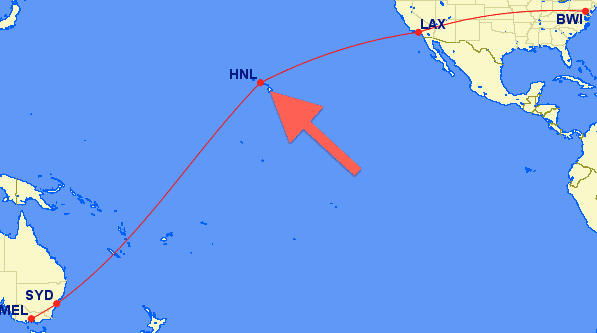
Imagine if you lived in Honolulu and took this routing. Onto your main Melbourne award home, you could be adding a free oneway to Baltimore.
Let’s look at another example. On an award from Los Angeles to New York to Boston to London, the North American International Gateway City is Boston because it is the city from which you leave North America. With this routing, Boston is the only place on the itinerary you can have a free stopover.

If you lived in Boston, LAX to Boston would be a free oneway before your main award to London. It is a free oneway because it won’t increase the miles price of the award.
Of course, you have some control over the routing and thus the airport where you can have a stopover. If you find space on JFK-LHR, the above itinerary could be Los Angeles to New York to London, meaning the free stopover would be at New York. That means a free oneway is easily added to a New Yorker’s award to London.
To construct a free oneway, you need to take a stopover at your home airport. That means AA free oneways are only open to those who live at an international gateway city for American or one of its partners. For a complete list of North American International Gateway Cities of all AA partners, see the list I compiled.
2. Each of the two directions-outbound and return–must not exceed AA’s Maximum Permitted Mileage for your origin and destination by more than 25% as flown.
This is not as complicated as that sentence makes it seem. Maximum Permitted Mileage (MPM) is a term of art. It is a number of miles that the airline puts on all city pairs for which it publishes a fare. MPM is not the direct distance between two cities; it is usually a larger number.
You can find the MPM for a city pair on Expert Flyer, the KVS tool, or by asking an AA agent. Here’s how to do it on Expert Flyer.
Crucial: You need to look up the MPM for the origin and destination as AA sees them–including any free oneways.
Looking back the Los Angeles to New York to Boston to London example, Los Angeles to Boston was a free oneway, and our flyer’s main award was Boston to London. That’s how our flyer sees it, but American Airlines sees it as an award from Los Angeles to London with a stopover in Boston. That means you need to look up the MPM for Los Angeles to London and not exceed that MPM by 25%.
Let’s look at another example. The double slash separates the free oneway from the main award.
Example: Say you want to try this routing, LAX-BOS//BOS-NRT-TPE. In words, a free oneway from Los Angeles to Boston preceding Boston to Taipei. First I would head to Expert Flyer, and I would look up the MPM for LAX to TPE, since that is the origin and destination.
LAX-TPE has an MPM of 8,137 miles. (Note that this is much farther than the direct distance between the two, which Great Circle Mapper lists as 6,799 miles.)
Next I would multiply the MPM by 1.25, since we can exceed the MPM by 25% on awards. 10,171 miles is 25% greater than the MPM of LAX-TPE. Now, I can go to gcmap.com and check the distance of our putative routing. LAX-BOS-NRT-TPE is 10,669, which exceeds the allowable 10,171, so this is not a valid routing.
That means that AA would break this into two awards–LAX-BOS and BOS-TPE–and you’d have to pay more. That means you can’t get a free oneway from Los Angeles to Boston before an award to Taipei.
3. The airline that operates the flight that connects the two regions must have a published fare for your origin and destination city pair.
This is a rule that trips up a lot of otherwise awesome awards. It’s frustrating, and it’s not clear why the rule exists, but you have to know it.
When interpreting this rule, the same caveat from the previous rule applies: make sure you are including your free oneways when figuring out what AA sees as your origin and destination.
Example: You live in Los Angeles. You want to fly Melbourne to Los Angeles on Qantas, then two months later you want a free oneway to Baltimore (via JFK). That means Qantas–the region connecting carrier–has to have a published fare from MEL-BWI for the free oneway to be valid and to avoid this being priced as two awards.
How do you figure out if there is a published fare between a city pair? I check on Expert Flyer. Here’s how. Another free, roughly accurate, way is to see if you can book a ticket between the city pair on the operating airline’s website or kayak.
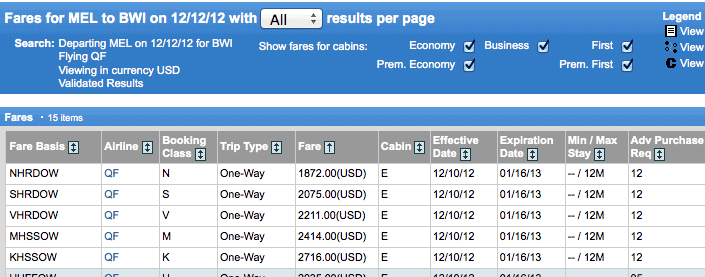
Or you can just see if you can have a routing price as one award over the phone. If you can, you have a legal routing and stopover.
4. All award travel must be completed within one year of its booking.
As I mentioned in the Introduction to Free Oneways post, this is a rule of all the legacy carriers.
You can have as long of a stopover as you want, you can stay at your destination as long as you want, and you can change your award to a later flight as many times as you want, subject to the fact that all travel must be completed within one year of the ticket’s issue.
Example 1: On January 1, 2013, you book MEL-LAX-JFK with a stopover in Los Angeles. MEL-LAX is January 2, 2013. Your maximum stopover in Los Angeles can be for nearly a year, you just need to complete LAX-JFK by December 31, 2013.
Example 2: On January 1, 2013, you book MEL-LAX-JFK with a stopover in Los Angeles. MEL-LAX is November 15, 2013. Your maximum stopover in Los Angeles is about a month and a half. You need to complete LAX-JFK by December 31, 2013.
Example 3: On January 1, 2013, you book MEL-LAX-JFK to be flown on November 15. In April, you decide to move the trip back. The latest you can move it back is to December 31, 2013 because all award travel must be completed within one year of the ticket being issued.
Bonus: Sometimes you may want to book a free oneway that occurs near the end of the one-year window. This can be impossible since AA only lets you book awards up to 330 days out.
This happened to me when I booked a Qantas flight from MEL-LAX 330 days out, and I wanted to add a free oneway to Tampa for a few weeks later. Here’s how to get your free oneway without having to pay a change fee to add it later.
When you call to ticket the award, tell the agent: “I want to stopover in LAX and add two more segments to Dallas then Tampa. The dates for those will be February 6. I know I can only book awards through January 15 today. Can you please add a note to the record about this, so that I can call back in to add those legs when they open up without incurring a change fee.”
Two-thirds of the AA agents I’ve asked to do this have done so. The other one-third, I hung up on, so I could call back to get a competent agent.
For a fuller treatment of this trick, see American Airlines Domestic Availability Trick.
5. Awards between Region A and Region B cannot transit Region C unless specifically allowed.
Many airlines let you route however you’d like as long as you don’t exceed MPM. But not American Airlines. If you want to go from the USA to Australia, you can’t transit another region, say Asia, no matter what.
Another annoying one is not being able to transit the Middle East en route from USA to Africa. That makes it impossible to use Etihad.
Here is a list of regions you can transit from flyerguide.com, which I believe is complete and accurate.
This rule doesn’t pertain specifically to free oneways, but it can ruin some otherwise beautiful routings like the US to India via Asia.
With those rules in mind, let me run through some itineraries to check their validity.
Puerto Rico-Boston//Boston-JFK-Tokyo-Taipei–invalid
(I created this example when there was a direct SJU-BOS flight on AA.)
If you live in Boston, Puerto Rico to Boston is an invalid free oneway before a trip to Taipei. This itinerary is going from North America to Asia, so the international gateway city is the last North American city, JFK. The only valid stopover point is at JFK.
Don’t be confused that Boston is the arrival point from Puerto Rico. Puerto Rico is part of North America according to AA’s inclusive definition: the 50 US states, Canada, Mexico, Bermuda, Bahamas, and the Caribbean.
This means that we don’t need to worry whether we can transit the USA en route between the Caribbean and Asia. The USA isn’t a “third region.” It’s part of the same region as the origin–North America.
LAX-BOS//BOS-NRT-TPE–invalid
From above: LAX-TPE has an MPM of 8,137 miles. This is the MPM to check because we need to find the MPM for the entire trip including free oneways. Multiply the MPM by 1.25, since we can exceed the MPM by 25% on awards. The MPM of LAX-TPE times 1.25 is 10,171. LAX-BOS-NRT-TPE is 10,669 miles, which exceeds the allowable 10,171, so this is not a valid routing.
NRT-BOS//BOS-JFK-SJU–valid
This itinerary has the stopover at the international gateway city, and it’s about as direct as possible, so no exceeding-MPM worries. But does Japan Airlines, the overwater carrier from Tokyo to Boston. have a published fare from Tokyo to San Juan? YES, according to Expert Flyer!
Booking a Free Oneway
American, Alaska, Qantas, British, Hawaiian, and Finnair are all bookable on aa.com, so if your planned itinerary includes only those airlines, you can avoid talking to a phone agent and save the $25 per ticket fee.
On the aa.com homepage where you can search flights, check the box that says Redeem AAdvantage Miles, then click the link that says Multi-city.
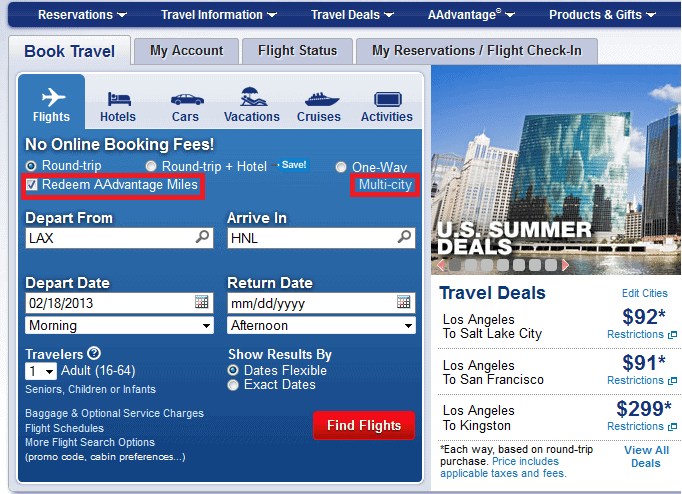 This will bring you to a screen like the one shown below. Note what I’ve highlighted in red boxes.
This will bring you to a screen like the one shown below. Note what I’ve highlighted in red boxes.
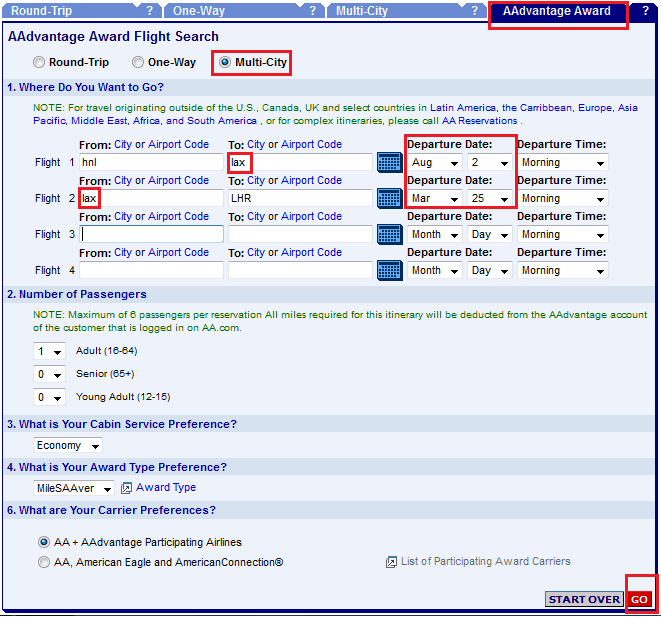 The first two things I’ve highlighted show that you should automatically be brought to the AAdvantage Award tab with Multi-city selected. If you weren’t brought there, get there. Next search for the itinerary until the stopover and for the itinerary after the stopover.
The first two things I’ve highlighted show that you should automatically be brought to the AAdvantage Award tab with Multi-city selected. If you weren’t brought there, get there. Next search for the itinerary until the stopover and for the itinerary after the stopover.
Here I’ll be searching for an award from Los Angeles to London (LAX-LHR) with a free oneway from Honolulu to Los Angeles beforehand.
So I’ve typed in HNL-LAX for Flight 1 and LAX-LHR for Flight 2. Important: Type in your origin to your stopover for Flight 1, and your stopover to your destination for Flight 2. Do not type in each individual segment. For instance if I wanted everything the same but a destination of Paris not London, I would type in HNL-LAX and LAX-PAR. I would not type in HNL-LAX, LAX-LHR, LHR-PAR.
Next I’ve highlighted the dates just to point out that free oneway and main award can be as far apart as you’d like, only limited by the fact that all award travel must be competed within one year of booking.
After filling out the form, click the red GO button.
You should now be brought to a screen like this:
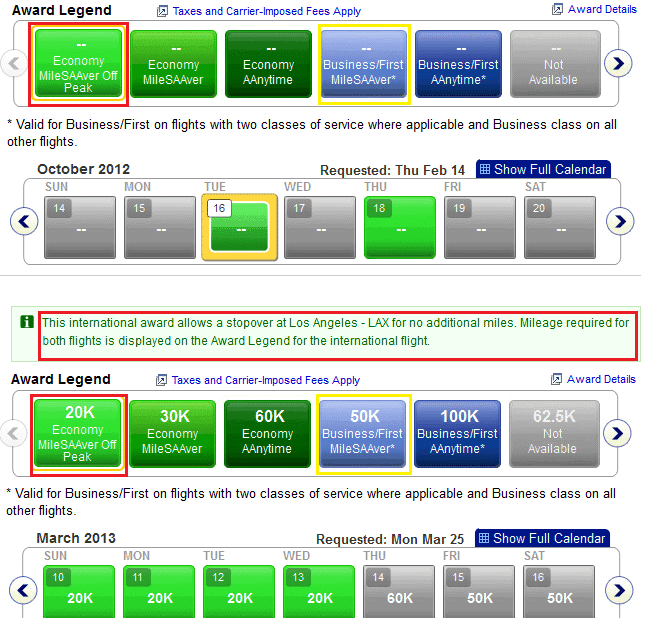 Look at what I’ve highlighted in the middle: the computer knows you’re getting a free stopover!
Look at what I’ve highlighted in the middle: the computer knows you’re getting a free stopover!
Now it’s up to you to choose what class you want. If you want Economy, select the Economy MileSAAver Off Peak for both legs. If you want business, select Business/First MileSAAver for both legs. First class is not available these weeks, but if it were, you’d select that in both places.
At the top, choose the date of the HNL-LAX leg. Why are there dashes instead of prices at the top? Because this is a free stopover, so the leg adds nothing to the miles prices, which are listed below for the main award leg.
After selecting dates, you can select flights. After selecting flights, we come to the checkout screen. Look at that price: 20,000 miles and $5 for 16 hours of flying!
What an incredible deal. And by knowing how to book this stopover online, we saved $25 and the hassle of calling American.
Don’t forget that you can get one free oneway per direction on international AA awards. And that the free oneway can be to Hawaii, Canada, Mexico, Alaska, the Caribbean, or the continental US. Here’s a roundtrip award with two free oneways–one from Hawaii and one to Canada.
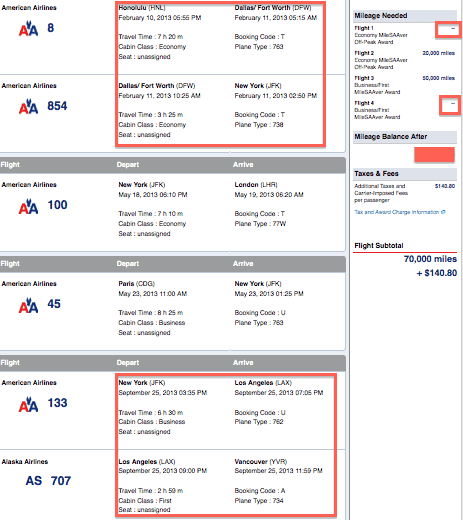 This award shows some of the many possibilities. The first free oneway–from Honolulu to New York–is before the main award. The second is after the main award from New York to Vancouver. (As a side note, were I to actually book this, I would look to get on the Cathay Pacific flight JFK-YVR for an incredible flat bed experience that has plenty of award space bookable by phone.)
This award shows some of the many possibilities. The first free oneway–from Honolulu to New York–is before the main award. The second is after the main award from New York to Vancouver. (As a side note, were I to actually book this, I would look to get on the Cathay Pacific flight JFK-YVR for an incredible flat bed experience that has plenty of award space bookable by phone.)
The award mixes-and-matches cabins. The outbound is in economy class. It’s off peak to Europe, so it costs only 20k miles. The return is in business class for 50k miles, hence the 70k total. The award is a double open jaw, out of Honolulu and into Vancouver plus into London out of Paris. (Always fly into London, out of Paris not vice versa to avoid the punitive taxes for flying out of London in premium classes.)
Here’s a free oneway I have coming up:
This award cost 62,500 miles, exactly what you would expect for a oneway in business class (on an A380!) from Australia to the US. The extra legs in first class to Tampa are the free oneway that cost me zero extra miles and only $5 in taxes. Don’t forget that international business class equates to two-cabin domestic first class, so you can ride up front on the domestic segments.
If you want to book a free oneway on an American Airlines partner that is not bookable online, call AA at 800-882-8880 to book. You will incur a $25 phone fee.
For search tips for other AA partners, see Using BA.com for Oneworld Award Searches.
Recap
Airline: American Airlines
How Many Free Oneways: One per oneway, two per roundtrip
What Types of Awards Allow Free Oneways: International Only
Free Oneways To/From Where: North America (50 US states, Canada, Mexico, Caribbean) subject to overwater-carrier-published-fare rule
Routing Restrictions: Cannot exceed MPM by more than 25% in either direction including free oneway, home airport must be North American International Gateway city, cannot transit third region unless explicitly allowed
Overall, I really love free oneways on American awards. The ability to add a free oneway to a domestic flight is unmatched. The ease of adding a free oneway to Hawaii is unmatched.
I happen to live in Los Angeles, which has direct service to five continents on AA partners, so I am spoiled by not having to worry much about the International-Gateway-city rule. If you live at an airport without international flights, stay tuned for Almost Free Oneways on American Airlines Awards.
The other drawback I haven’t mentioned yet is that American collects surcharges of about $300 per British Airways longhaul segment, so BA is generally not the airline you want to fly transatlantically on AA awards.


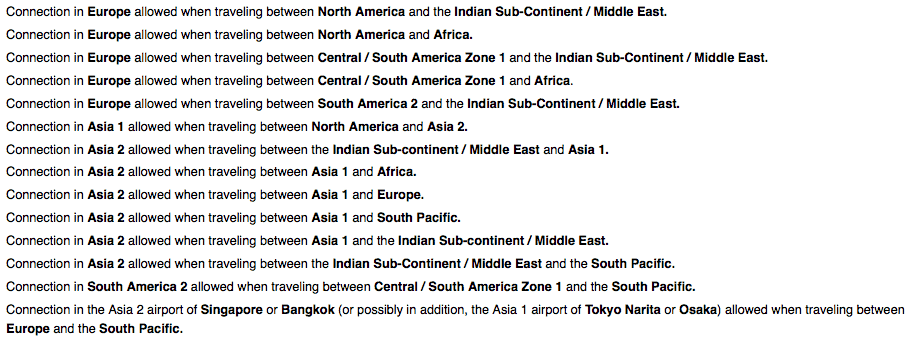

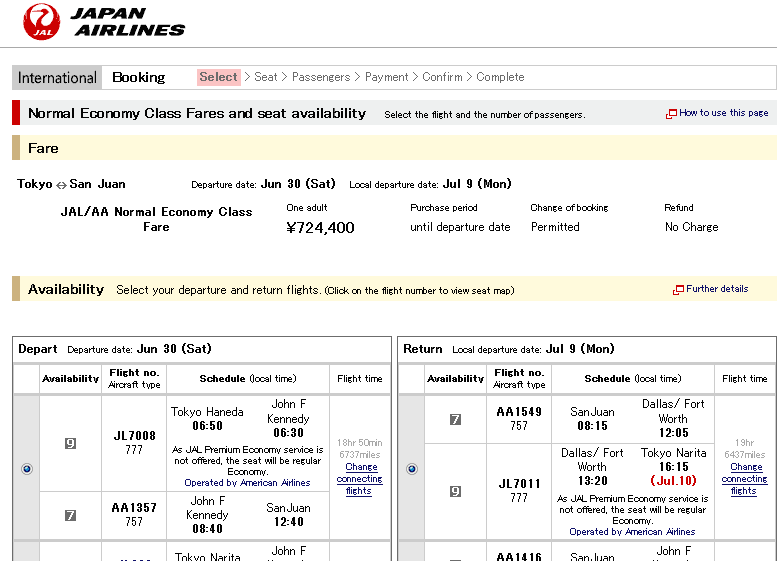
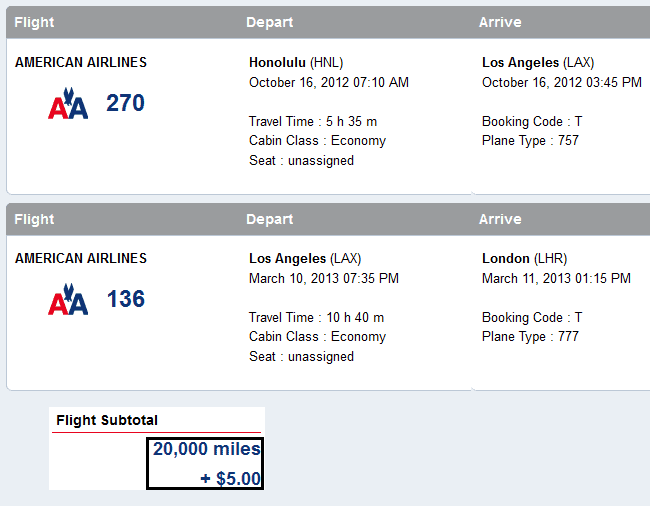

I’ve read your entire post and WOW that’s a lot of information!
I look forward to hearing your presentation at the LA FTU and hopefully we can meet.
Thank you again! I cannot imagine how much time it takes to compile the information, and then write about it.
I’d love to see this presentation in person. Thanks for sharing. Maybe I can get to an event to see this live. Great Work.
Thx for this info Scott! If I already have booked LAX-CDG-LAX for next year on ATN using AA miles, can I now go back and add the two one ways? I made the original reservation via phone, so do I need to make the change via phone (if I can add the two one ways) or can I do it online? I assume the original $25 will count for any changes to the itinerary…correct?
[…] Using the Mile Value Leaderboard, you can see that Scott values American miles at 1.77 cents. AAdvantage has solid online award availability (including partners British, Hawaiian, Qantas, airberlin, and Alaska) and also allows free oneways on award travel. For more information, make sure to check out his full posts, Master Thread: Free Oneways on American Airlines Awards. […]
This is complicated stuff! I have 2 RT booked on AA award on CX from LAX-HKG-TPE and return SGN-HKG-LAX. I’m confused on how to take advantage of the free one way. From what I read my “stop over” is in LAX and I can add a free one way to LAX on outbound and another on the inbound. I thought about side trip to HNL but cathay has no published fare there. Will SFO or LAS work? If I book SFO-LAX//LAX-TPE and do not use the free leg SFO-LAX will that cancel my main trip? On the return, SGN-HKG-LAX//SFO or LAS, I guess it wouldn’t matter if I end up not using the free one way.
Great post! Could a person get around the restriction of International Gateway City :” That means AA free oneways are only open to those who live at an international gateway city for American or one of its partners.” by landing in the International Gateway City and figuring out a way to get home? e.g. if a person lives in Cleveland.. could they just construct the award booking as if they are flying out of JFK and take a cheap one-way from JFK to Cleveland?
😉 https://milevalu.wpengine.com/how-to-get-an-almost-free-stopover-almost-anywhere-on-american-airlines-awards/ https://milevalu.wpengine.com/almost-free-oneways/
Can i use Avios points to do this? will the BA people on the phone let me use this free oneway?
Thanks!
[…] The video is a companion to Master Thread: Free Oneways on American Airlines Awards. […]
i’m trying to book a flight from LHR-SYD with a stopover in HKG. AAadvantage is telling me that i cant have a stop over. is this correct?
AAdvantage awards can only have stopovers at the North American international gateway city. Since your itinerary doesn’t touch North America, you can’t get a stopover.
Scott, great post with lots of info ….need to read it again to digest everything…lol.
Want to fly ORD – OTP and then FRA – ORD next year in June. I can add free OW’s to OGG
before and after, correct? I want to avoid LHR but most of the flights on AA go thru there.
Quantas wasn’t helpful either. Any suggestions on your part???
Thanks a million for your response
Hi Scott — your blog is fantastic, especially the free one ways and the 20k to Europe anytime trick. Love that you’re focusing on how to optimize your use of miles, not just how to earn them.
I’m currently booking a trip to Argentina for next November, using AA miles and Avios on (mostly) LAN. Right now I’m working on the return trip: EZE – NYC for 11/16/2013, using the BA website to search availability. Some interesting things going on:
1. Certain LAN flights disappear just one day after becoming available. Yesterday I saw plenty of open spots on flight LA 532 EZE – JFK via SCL. Today there is space on the leg from SCL – JFK, but none from EZE – JFK. I noticed similar patterns searching for other LAN space 331 days out… plenty of seats that disappear after a day. Did 532 really fill up that fast or did LAN take away the award seats?
2. Since I missed booking the LA 532 flight (AA reps were jammed with the snowstorm yesterday), I’m stuck with LA 2428 EZE – LIM, connecting to LA 530 LIM – JFK. When I put the flight on hold this morning, I was told that it priced as two awards, 12.5k + 20k, instead of the 20k I was expecting. Is this correct?
3. I’m hoping that some AA space opens up at the 20k level for 11/16 (will know tomorrow AM). If it doesn’t, do you think I will be able to add a free one-way NYC – SAN to my LAN EZE – JFK flight?
Appreciate your thoughts!
1) LAN probably pulled it.
2) Yes, see rule 5. –> https://milevalu.wpengine.com/the-five-cardinal-rules-of-american-airlines-awards/
3) I would think so, it all depends on MPM (see rule 2 above) but I think you’re in the clear.
[…] me a new perspective on free oneways. Hopefully everyone reading this has already read about adding Free Oneways to American Airlines awards. It’s a great way to add value to American Airlines international awards, and I’m using […]
[…] 30 days and 24 hours before departure, you can reserve your entree. I have an upcoming free oneway in American first from Los Angeles to Dallas to Tampa, so I decided to pre-order my […]
Scott – We just started getting into miles and points last year and have found your blog incredibly informative! We’re ready to start burning some miles. Thank you for sharing so many tips and going into detail on how to get the best deals. It’s still pretty overwhelming for newbies.
In the next month we will have 166K AA miles, 200K United miles, plus smaller balances on a variety of other carriers. Need some advice on where to get started: trying to plan a 2 week trip ( 2 adults, 2 kids) in August from PDX to Europe (hitting London, Paris, Rome). Must be back in states by 9/4. Need to avoid high fuel charges. Economy is fine. Would love to get a free one-way out of it, but not sure that is possible since PDX is not considered international gateway by AA.
Do you think it can be done on one carrier, or will it have to be one-ways on AA/United? Your advice would be greatly appreciated!
Scott, do you know if those free one ways are bookable on Hawaiian Airlines?
I’m putting together an itinerary JFK-ORY-JFK//JFK-OGG. i called AA and was told by two separate agents that to add a free one-way to hawaii it has to be on AA flights only. when i tried to feed the agent the info on the leg on HA, the ticket priced out at 17.5k extra miles for a total of 67.5k for the above itinerary in coach. any advice if there is a way around it to get the HA flight added free? thank you !
The agents are incorrect. You can use an AA or partner flight. The problem is probably that there is no published fare on your Europe – USA carrier from ORY-OGG.
that could makes sense. so in other words, if my return leg from europe was on AA instead of AB, the hawaiian air free stopover should be bookable since AA flies ORY-OGG?
See https://milevalu.wpengine.com/the-five-cardinal-rules-of-american-airlines-awards/
Look at the rule about published fares. You can check expertflyer.com to see if the carrier from Europe to USA has a published fare from ORY-OGG. If not, try ORY-HNL.
I should probably know this, but what about checked bags? Don’t they try to check your bag through for the whole trip? How do you get the bag to just go as far as you are going on that one part of the trip?
If you have a stopover of more than 24 hours, your bags will be checked to that stopover point not to the end of the itinerary that is months later.
[…] On any award returning from Europe, you should be able to get a free or cheap oneway to Hawaii. Zero miles or 9,000 Avios is a better deal than 15,000 AA […]
Wow thank you for all this info…so incredibly insightful. One thing I can’t figure out:
Say I want to fly JFK->NRT. In order to take advantage of free oneways, I’m going to book AUS->JFK, JFK->NRT, NRT->JFK, JFK->AUS (I live in NYC). Is it possible for me to, after booking, move the first AUS->JFK leg to a time in the future that would be after my JFK->NRT flight?
Thanks so much for the help!
Not possible. This works because you are allowed a free stopover at JFK on your way from AUS-NRT in the airline’s eyes. That means the order has to be AUS-JFK-NRT-JFK-AUS
So if I know i need to take a specific JFK-NRT and NRT-JFK flight, i guess the only free oneway I can get is after the trip, JFK to somewhere else. Think I got it. thanks
[…] Free one ways on American […]
[…] is my international gateway city, that means I could add a free domestic one-way in first class (subject to some rules that are better explained on other blogs) prior to my trip to BKK. I decided that I might as well use this opportunity to get a free one-way […]
I’m based in LA and looking to take advantage of the free stopover, I found some availability for HNL-LAX-BCN-LAX-HNL for just 40k off-peak. Will AA then let me change the dates/order so that I essentially have two separate trips?….LAX-HNL-LAX and LAX-BCN-LAX? Thanks for the info!
You cannot change the order. The trip has to remain Honolulu to Barcelona to Honolulu in their eyes.
[…] advantage of a free one-way or two. MileValue has a great explanation of all this for AA awards here. It's a great way to increase the value of your award redemption. United is also a great option for […]
[…] I promised you more than just the roundtrip award. For zero extra miles (and a pittance in taxes), we can add two free oneways to your award. For full details on free oneways, see Master Thread: Free Oneways on American Airlines Awards. […]
[…] Free Oneways on American Airlines Awards […]
[…] AA because I just did but you might be able to do it with DL too. Check out these MileValue posts: https://milevalu.wpengine.com/master-thread-f…rlines-awards/ http://feeds.feedblitz.com/~/t/0/_/f…-delta-awards/ Also I wish we had had more time (both off […]
[…] Francisco, since it is a rare international oneworld flight from SFO, making it eligible to have a Free Oneway on American Airlines tacked […]
I have the following booked:
SAN – EWR
…3 month stopover…
JFK – EZE
If a better flight opens up from SAN – JFK, can I switch to that flight since JFK/EWR are both NYC airports? Thanks!
[…] Master Thread: Free Oneways on American Airlines Awards […]
[…] North American International Gateway City is also your home airport, now you’ve unlocked two Free Oneways on American Airlines Awards per roundtrip. (Or if you live within a short direct flight of Los Angeles on American Airlines or […]
[…] (There’s more to it than I could explain in those two sentences. See Master Thread: Free Oneways on American Airlines Awards.) […]
[…] to the free stopovers advantage that awards have, try to add a free oneway to your next cash ticket. It will certainly price as a separate ticket instead of […]
If you are stationed within the UK and wish to go to HNL via LAX and have BA executive club avios is it possible to get the “free stopover?”
BA charges you for every segment you fly on awards. That means unlimited free stopovers (one after each flight) but no possibility of a free oneway.
[…] How to Book Free Oneways on American Airlines awards […]
I have an upcoming trip in 2014: ORD-HKG (Business) and MNL-HGK-ORD (coach). Can I add another trip, maybe to the East Coast before and after ORD? Thanks!
Thanks for so much awesome info.
I have a question, though…Im trying to book an award on the date April 17, 2014 from CDG to SAN and I’d like to add the extra free trip. The flight shows up at 60k miles if I select one way travel, but whenever I select multi-city it says unavailable at any mileage.
You know why that might be?
On American? I don’t know. Search segment-by-segment and call in.
[…] I put everything there is to know about free oneways on American Airlines awards into Master Thread: Free Oneways on American Airlines Awards. […]
Your assistance would greatly be appreciated. I booked a 62,500 mile first class award ticket from Miami to Washington Dulles, layover for 8 hours, then Dulles to London (LHR) on American Airlines in March 2014. Would it be possible to change the itinerary to go to Hawaii (HNL) in 2014? My current itinerary is MIA-IAD-LHR. I understand my gateway city is IAD. Could I do MIA-HNL-IAD-LHR?
Thanks,
No, check this post out: https://milevalu.wpengine.com/the-five-cardinal-rules-of-american-airlines-awards/
Hey Scott,
I would really appreciate if you can help me with this question:
I’m trying to book NYC-GRU with a free stopover in MIA.
AA’s website is pricing it as a free stopover HOWEVER, since the NYC-MIA portion is for Jan 23, a date which falls into the “peak dates” category, AA is pricing the whole trip as peak, hence charging me 30K miles instead of 20K off peak which would be charged for just the MIA-GRU on Mar 17.
This is what I was thinking of: Would I be able to book the NYC-MIA for sometime in March for a total of 20K and then change the date of that flight back to the desired Jan 23 date without getting charged the additional 10K miles?
Or maybe you have some other advice for me here?
Thank you for all you do, I read milevalue daily!
[…] way award to Europe in the height of summer for only 20k miles, which is a 10k mile discount plus a free oneway from Los Angeles to New York, a 12,500 mile […]
[…] Master Thread: Free Oneways on American Airlines Awards […]
[…] Free one-way ticket anywhere using American Airlines – yes, please! […]
[…] Master Thread: Free Oneways on American Airlines Awards (dead as of April 2014) […]
[…] Master Thread: Free Oneways on American Airlines Awards (dead as of April 2014) […]
[…] I recently put everything there is to know about free oneways on American Airlines awards into Master Thread: Free Oneways on American Airlines Awards. […]
[…] applying the same trick I used in the post 20k Miles to All of Europe All Summer, and I also added two free oneways onto the award, so that they already have half of their next vacation to Hawaii […]
[…] daydreaming about a trip from Hong Kong to Los Angeles on Cathay Pacific First Class with a later free oneway to Tampa. For the free oneway, I had in mind flying the Los Angeles to Miami leg in three-cabin […]
[…] way award to Europe in the height of summer for only 20k miles, which is a 10k mile discount plus a free oneway from Los Angeles to New York, a 12,500 mile […]
[…] “Yes,” I replied. “In April, American removed the ability to add a free stopover to awards under all circumstances. It was a super bummer because I used to use the free stopovers for free one ways.” […]